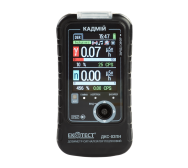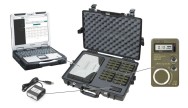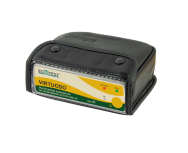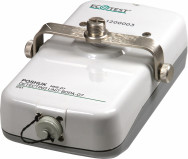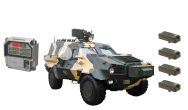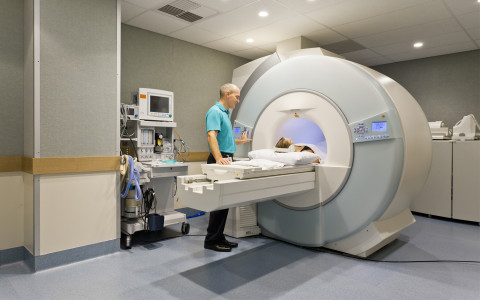Human senses are incapable of detecting ionizing radiation. That is why we need the right type of detection device to monitor the level and duration of radiation exposure. Handheld radiation monitoring devices get routinely used for this purpose.
Types of Radiation Exposure
It is possible to categorize radiation exposure from different perspectives. From the aspect of sources, we can classify radiation exposure into two basic types:
- Ionizing radiation sources external to the human body
- Radiation sources that can enter the human body through inhalation, etc. Radioactive dust and aerosols are typical examples.
From the perspective of dosage, radiation exposure can be high or low. In addition, exposure to environmental radiation is inevitable.
Differences In The Biological Effects of Low- And High-Dose Radiation
Radiation leads to the ionization of atoms. The ionization of atoms has the potential to affect molecules. Affected molecules can have an adverse impact on the cells, which may – in turn – affect tissues. Tissue damage affects organs.
The possibility of such a chain reaction means that radiation exposure can affect the whole body. That is why exposure monitoring and limitation is vital.
Experts classify the biological effects of radiation exposure as of two types:
- Acute or short-term effects resulting from exposure to high doses of radiation over a short period of time.
- Chronic or long-term effects caused by exposure to low doses of radiation over a long period of time.
The basic difference between the two types of effects is that high-dose exposure kills cells while low-dose exposure damages them. The impact of low-dose radiation exposure may not even be visible immediately.
We’ll return to the health effects of low-dose radiation in the next section. In this section, we elaborate on the effects of high-dose radiation exposure.
High-dose radiation exposure can kill so many cells at a time that tissues and organs become damaged. This may lead to a whole-body response known as Acute Radiation Syndrome (ARS).
High-dose radiation exposure is not limited to deliberate actions such as the bombing of Hiroshima and Nagasaki. Neither is it restricted to serious nuclear accidents like Chornobyl.
There are recorded incidents of people dying from accidental high-dose radiation exposure at workplaces. There are also documented cases of inadvertent tragedies.
However, not all cases of short-term exposure to high-dose radiation result in death. Both the dose level and the exposed person’s state of health at the time of exposure play a role.
Homeland Security’s guidelines on emergency response to high-dose radiation exposure offer the following information:
| Radiation Dose, rg | Observed Effects |
| 15-25 | Changes in the blood count of a group of people |
| 50 | Changes in the blood count of an individual |
| 100 | The most sensitive among the exposed individuals will start vomiting |
| 150 | The most sensitive among the exposed persons will die |
| 320-360 (lethal dose) | 50% of those exposed will die within 60 days with minimal care |
| 480-540 (lethal dose) | 50% of the exposed people will die within 60 days with supportive medical care |
| 1100 (lethal dose) | 50% of the exposed people will die within 60 days with intensive medical care |
Cataracts, hair loss, burnt skin, and sterility are also some of the possible effects of high-dose radiation exposure.
Health Effects of Low-Dose Ionizing Radiation
Low-dose radiation exposure can be of three types:
- Genetic: The effects become visible in the child of the exposed person. The impact can be from either or both the parents.
- In-Utero: The embryo or fetus in the womb suffers the consequences of the mother’s exposure to low-dose radiation.
This is different from the genetic effect on two counts. In-Utero impact happens only if the mother gets exposed. Also, the genetic effect is on a child conceived after the exposure.
- Somatic or Carcinogenic: The person exposed gets cancer.
The health effects of low-dose radiation are not always negative, though. A process medically known as the low-dose radiation hormesis of the immune system is a beneficial impact.
What Is Low-Dose Radiation Hormesis of the Immune System?
Ionizing radiation in doses marginally above the level of environmental radiation occurring naturally activates some beneficial repair mechanisms. That is known as radiation hormesis.
These repair mechanisms offset the harmful impact of the low-dose radiation exposure that triggers them. In addition, they help prevent other diseases that might occur from exposure to other risks.
The beneficial effects of radiation-hormesis include:
- Activating the immune system to recognize mutated cells vulnerable to neoplastic transformation.
- Stimulating the enzymatic DNA repair mechanism.
- Apoptosis activation to cleanse the damaged cells vulnerable to tumorigenesis.
- Enhancing the antioxidant responses.
Assessment of Risks from Environmental Radiation
Environmental radiation occurring naturally is the main source of long-term low-level radiation exposure for most people. Radon, a radioactive gas emanating from the ground, is the most important source of natural background radiation.
The level usually ranges from 1.5 to 3.5 millisieverts per year, but it may rise up to 50 millisieverts/year also.
Research has revealed that long-term exposure to low doses of radiation exposure can be damaging to DNA. However, the exact effects of exposure to environmental radiation are yet to be fully ascertained. Research for assessing the impact is ongoing.
Devices Typically Used For Radiation Dose Monitoring
To prevent undue exposure to the harmful effects of radiation exposure, radiation detection instruments get used on a regular basis. For measuring the cumulative external exposure to radiation, dosimeters get used routinely.
Radiation Emergency Medical Management (REMM), a unit of the U.S. Department of Health and Human Services, mentions 8 different categories of radiation dosimeters for monitoring radiation dose and exposure levels.
Typical instruments for monitoring radiation dose and exposure level are:
- Dose Rate Meters to monitor immediate exposure to external radiation
- Aerosol or gas contamination monitors to signal potential internal exposure in the case of a radioactive substance being present in the atmosphere
- Nuclear Rate Monitors to assess surface contamination
Examples of dosimeters EcotestCARD and ІТ-09Т Data Panel
To Conclude
Radiation exposure is sometimes inevitable. Simple handheld radiation dosimeters are good for personal exposure monitoring. Especially for persons in professions that involve exposure risk.





